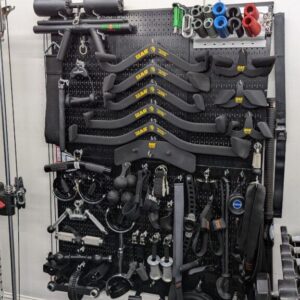RPE – The Most Confusing Scale, Simplified – 2025
You’re scrolling on Instagram and see a lifter post that they hit a top double at RPE sub 6, or RPE 8.5, or RPE *insert exploding brain emoji*. Is that good or bad? What the hell does that even mean? That’s why I’m here.
Hi, I’m Manda, and I will be your tour guide into the world of RPE.
RPE stands for “rating of perceived exertion”. As the acronym implies, the scale is subjective. It goes from 1-10 and is used for a lifter to gauge how hard a particular set/weight is. Instead of using a number based off a % of their one rep max. For example, your warm up weights are an RPE 6-7, working weight (if not a deload) is typically 8+.

Table of Contents
Key Notes
RPE, or Rate of Perceived Effort/Exertion, is a key factor in most powerlifting programs. It is a powerful tool when used correctly, and outright garbage when used wrong. Make sure you understand RPE, RIR, and the differences, and how to use them, so you can make MORE gains in the gym.
Transparency Note
Some of the items and links in this article might be affiliate links, or might be linked to a Sponsor of the Garage Gym Competition. These links and sponsorships help fund the website, the competition itself, the newsletter, non-profit donations, and everything else we do FOR FREE here at the GGC. I like to be transparent so you know what is up. I appreciate the support if you choose to use the links.
Wait, What?
On a Scale of 1 to 10, how hard was the set? The too long, didn’t read version of RPE is often this chart below. Keep in mind that this isn’t exactly perfect. We are taking a subjective concept of rating a sets difficulty, and letting the athlete determine the right rating. Film yourself and ask 10 different people what the RPE is. I bet you’ll get at least 7 different answers (some of which are, wtf is RPE?). The chart below gives us a starting point to understand what we might be looking at, so we can build off of it into the future as we better understand and apply RPE.

Who Should Use RPE
RPE is a great tool when used correctly. As mentioned before, it is a subjective scale to measure intensity. So the lifter must have a good grasp on what they are capable of. For this reason, I personally do not suggest using RPE based training if you are a newer lifter. You need time to figure out what maximal load feels like, to make RPE reliable.
Newer lifters are more likely to undershoot what they felt their intensity rating was. Newer lifters also tend to get stronger, quicker. The newer you are, the less “perfect” your programming needs to be to be effective. So for the most part you just need to show up and work hard, to move the needle. RPE has a lot of potential advantages, but also plenty of disadvantages if done incorrectly.
Compound those over the course of multiple training blocks and you have a recipe for stagnation, injury, and more. However, If you are someone with training maturity and can be honest with yourself, give RPE a shot. It can be a great way to be more accurate day in and day out with your abilities and training.
Figure It Out
If you want to start using an RPE based training format, you need to first figure out your RPE 10. I suggest doing low volume compound lifts like Squats, Bench, and Deadlift. Do 3-5 reps to an RPE 10 to get a number to base your RPE from. This will help you begin to convert percentages (what you probably did before), into RPE, as you learn more and more what you are capable of. As you adapt to this style of training, you’ll be able to adjust those 10 RPE numbers up or down.
RPE vs Percentages
It’s easy to calculate what 70% of 100 lbs is, which is why percentage based lifting is so commonly used. But RPE works well for those who can autoregulate to the day. Potentially your kid woke you up at 2am, and 4am, and 6am the night before. You probably shouldn’t expect to walk into the gym and crush your best lifts.
Percentage based lifting will have you hitting the same numbers no matter way. 70% doesn’t change because you didn’t sleep and feel like shit. Or maybe you had your favorite meal last night, your spouse and you had some special adult time, and you slept like a hibernating bear. Your previous best might NOT BE ENOUGH for today. Again, 70% doesn’t change because you are ready to attack the weights.
RPE allows you to bob and weave between good and bad days to keep the training moving forward instead of stagnating, missing lifts, or undertraining. Percentage based lifting is 100% based on what you have done in the past on one singular day. RPE is based on RIGHT NOW.
The beauty of RPE is that it works around these factors of life. If you are aware of what it feels like to put everything into a lift versus leaving a little in the tank, then you can keep your intensity where you want by using the right weight for today. If you are someone with training maturity and can be honest with yourself, willing to change your working weight based on how you feel and not your ego, RPE can be a great way to program.
How to Measure Progress with RPE
Let’s say a lifter does squats, and does 225 for a 4×4 at RPE 9. This means that on each set of four, they could have done one more rep if required. The next week, another 4×4 at RPE 8, and were able to use 225 again. Meaning they would have had two more reps in the tank after each set. We didn’t add reps, we didn’t add weight, and we didn’t add sets. But that same 225 x 4 x 4 GOT EASIER. That is progress. Something percentage based lifting would not account for until you retested your 1 Rep Max potentially months in the future.
This lets you bump up your lifts on consecutive workouts where applicable and continually tweak the RPE and working weights as you progress. If that RPE from week to week isn’t improving, or potentially getting worse, you can adjust as needed as well.
Measuring RPE With Accessories / Reps In Reserve (RIR)
Because we rarely know our 1 Rep Max for Lat Pulldowns, or Leg Extensions, I program my athletes to do accessories at a given RPE/RIR. This allows us to work towards a certain feel of difficulty for the sets. The literate tells us that for a set to “work”, it likely needs to be within 3 or 4 reps of failure.
So this can make it easy to program multiple sets of accessories for an athlete, especially if they are doing them AFTER some heavy compound lifts, while making sure they are effective, but not too destructive. Doing leg extensions after a bench session is likely easier to push the weight, than doing them after squats. But with RIR, we don’t have to be forced to tackle a certain weight, instead chase a certain feeling for our sets.
What Is RIR?
RIR stands for “reps in reserve”, which is often used interchangeably in the lifting world with RPE, but more so used on higher volume sets. Where RPE is gauged normally after the fact to assess how intense the lift was, RIR can be used while the set is being performed. For this example, we will use RIR 1 for 10 reps on lat pulldowns. To be true to RIR, all reps must be completed with good form.
The weight chosen will be such that at the end of each set, you are fatigued, but could do one more (tough) rep if required. Sets programmed to failure or “max” will mean take it until it’s an RIR 0 and you cannot perform any more reps before mechanical breakdown or muscle failure.
If this is all jiving, you might be seeing how a program could use BOTH RPE and RIR in the same workout. An athlete might be asked to do several sets of squats at 7, 8, and 9 RPE of sets of 3 to 5 reps. Followed by accessories of Leg Extensions, Split Squats, and RDLs all with multiple sets of 7 to 9 RIR for sets of 12 reps.
RIR might also, arguably, be a better system for higher rep work. Think about trying to pick the right weight for an RPE 8.5 set of Squats for 15 reps. Instead, you might be better off simply saying “leave about 2 in the tank” and going for it. Where as RIR is a little more difficult to use effectively on lower rep work. If your 1 Rep Max is a 600lb deadlift, a 585lb deadlift is probably a 9RPE, but you aren’t likely to crush a second rep.
Mental RPE
I am addressing this per a question I received on my Instagram. We are often our own worst enemies when it comes to lifting, especially as the weight gets heavier. This is why I cannot suggest enough to record your lifts. An experienced lifter is able to look outside themselves and watch how the weight moves to gauge the RPE. Heavy weight feels heavy, there’s no way to circumvent that; but if you’ve been in the game long enough, you know what a rep looks like when you have one or two more in the tank, or are at an RPE 9.5 and can add a small bit of weight if you’re looking for a new 1RM.
Sometimes we are tired, not in the mood, and everything feels like crap from the jump. But if we are able to see how the weight moves, and look back a couple weeks at our previous numbers and what our perceived RPE was, this can help set the tone for the current workout. We are stronger than we think, and ego and emotions can cloud that, often at inopportune times. Sometimes, you just have to believe in yourself for 5 minutes; after all, you believed in Santa for like ten years.
Summary
RPE is a great tool to use when you have a hectic life, or want to switch up from training based on a % of your 1RM. It allows for progress without overly fatiguing yourself, and can be a great way to improve one’s psychological relationship with their body.
In strength,

📌Enjoy Powerlifting? Want to enter a FREE competition with thousands of dollars in prizes and donations to non-profits? Check out our next event!
🏅 Own a home gym? Like to save money? Check out my full list of discount codes.



